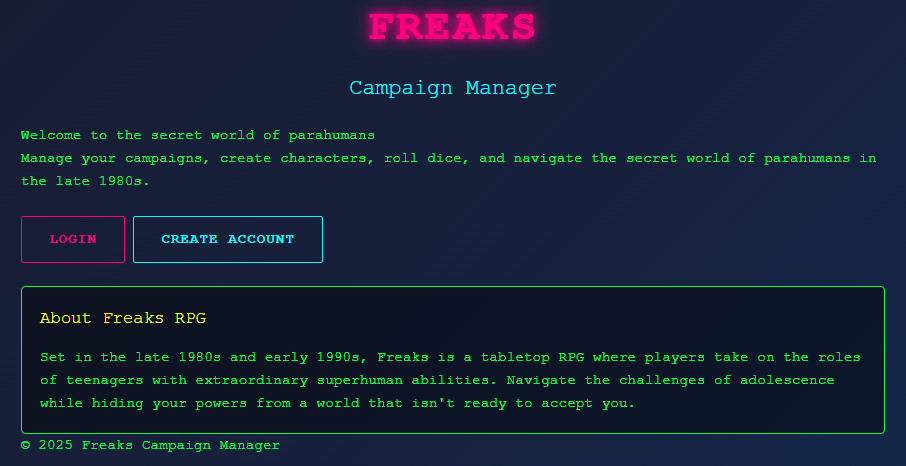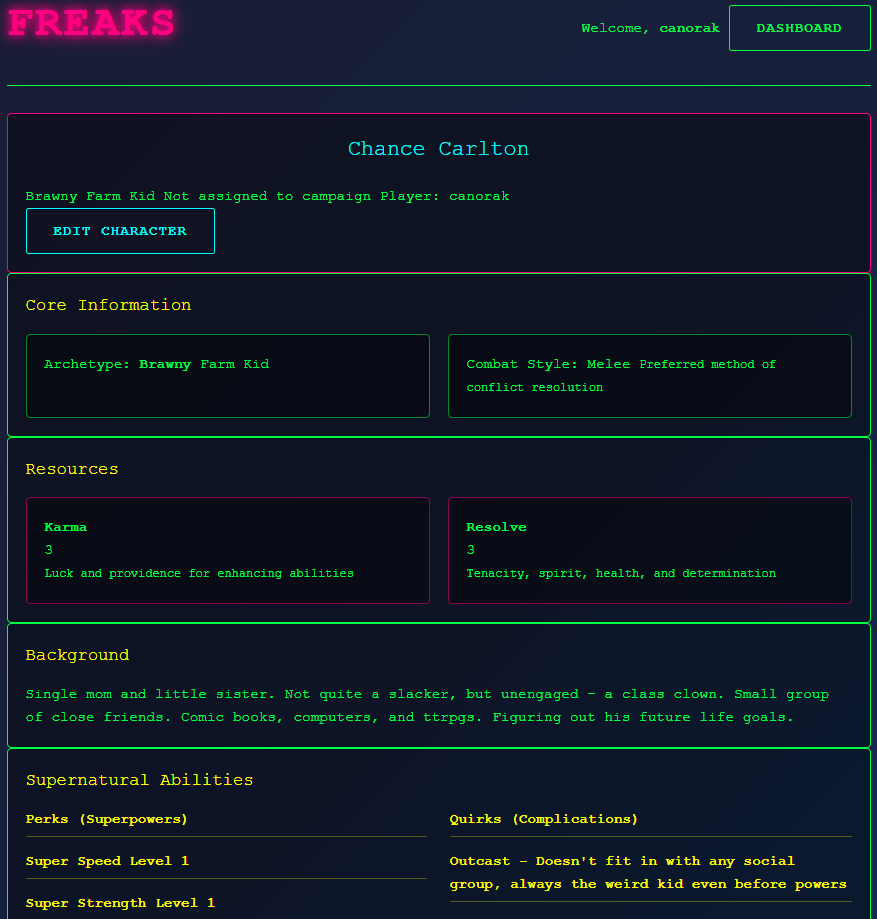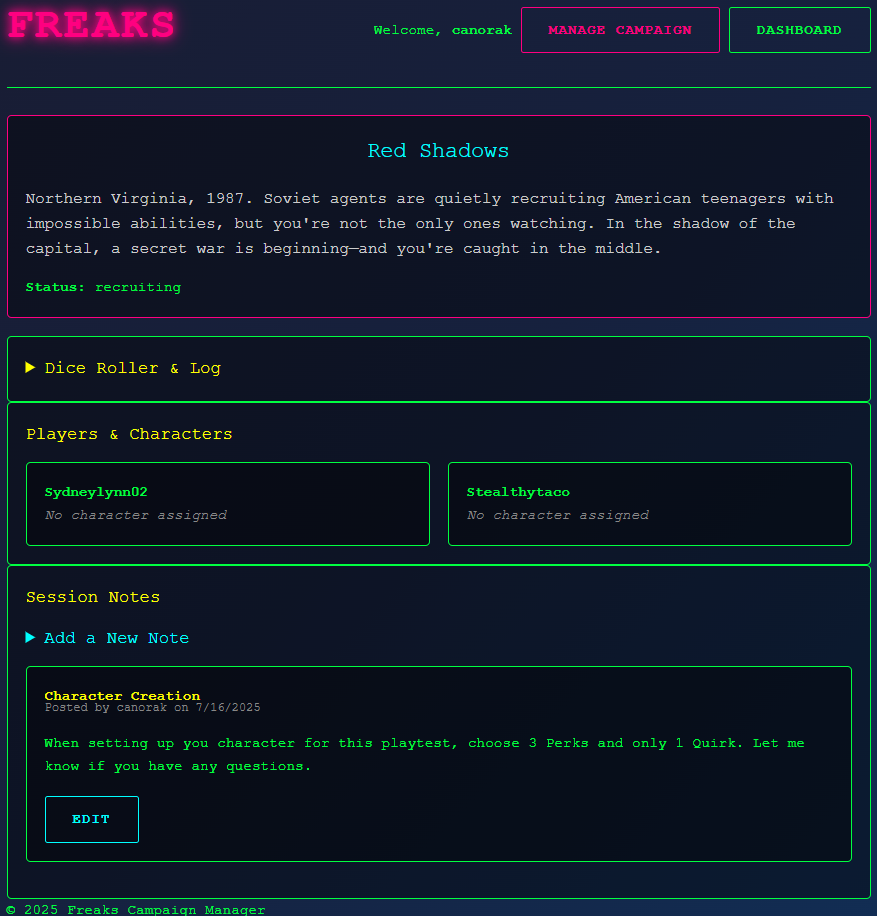Blackwood Institute and the Wider Parahuman Underground
Character Advancement Testing
Following our recent perk system overhaul, we had players rebuild their characters to test the enhanced power descriptions and new leveling mechanics. The goal was to evaluate balance and player satisfaction with the more detailed power listings.
Updated Character Builds:
Josh (Tommy Oliver) – Agile Skater
- Perks: Super Speed (Level 3), Phasing (Level 2)
- Quirks: New Kid, Conspiracy Theorist, Visible (new addition)
Larrett (Jimmy “Christoph” White) – Crafty Country Kid
- Perks: Regeneration (Level 1), Energy Constructs (Level 4)
- Quirks: New Kid, Language Barrier
The Visible quirk addition for Tommy reflected how his powers now manifest with glowing eyes and energy auras – a perfect limitation for his high-level abilities. Jimmy’s advancement to Energy Constructs Level 4 (property-scale, 300-foot radius) made him a powerhouse while maintaining clear limitations.
Sessions 4-5: Expanding the World
The Blackwood Institute
These sessions marked a major expansion beyond the local D.C. area, introducing Tommy and Jimmy to the Blackwood Institute – a secretive mountain school serving as a sanctuary for young parahumans. This gave players their first glimpse of what organized parahuman support could look like outside government control.
Dr. Blackwood was particularly impressed with their teamwork during a confrontation with Prometheus Initiative operatives – a corporate recruitment scheme that proved not all parahuman threats come from government agencies. The encounter showcased how the enhanced power system created meaningful tactical choices:
- Tommy’s Level 3 Super Speed (neighborhood-scale) allowed complex battlefield positioning
- Jimmy’s Level 4 Energy Constructs (property-scale) provided both offensive capabilities and protective barriers
- The Visible quirk forced Tommy to be strategic about when to use his powers
- Jimmy’s Language Barrier created interesting communication challenges during high-stress situations
The I-287 Incident
The drive home became its own crisis when the duo encountered Taylor Kim, a teenager whose gravitational powers had spiraled completely out of control during a family argument. This scenario perfectly tested the game’s core tension: exposure versus helping others.
Jimmy’s creative solution – using his Level 4 Energy Constructs to fabricate a fake meteorite at the center of the destruction – provided local authorities with a barely plausible cover story. This demonstrated how high-level powers can solve problems in unexpected ways while maintaining the secrecy that defines the setting.
The Corporate Angle
The Prometheus Initiative introduced a new faction beyond government agencies and anarchist Liberation Fronts. These corporate recruiters represented the capitalist approach to parahuman exploitation – offering money, opportunities, and “legitimate” careers in exchange for abilities. This added another layer to the moral complexity players must navigate.
System Performance
Enhanced Power Descriptions
Player Feedback: “Everyone said they enjoyed the changes and more detailed power listings. Balance seemed to be on point.”
The overhauled perk system successfully addressed earlier balance concerns:
- Level scaling felt meaningful without becoming overwhelming
- Detailed power descriptions eliminated ambiguity about capabilities
- Clear limitations prevented game-breaking combinations
- Quirk integration provided natural checks on powerful abilities
Memory Manipulation Resolution
The controversial Memory Manipulation power from previous sessions was refined based on playtest feedback. The new version requires specific, plausible memory alterations rather than wholesale personality changes, maintaining story consistency while providing useful utility.
Campaign Manager App Enhancements
Threaded Messaging System
The campaign management app received significant updates based on playtest needs:
Enhanced Session Notes: The basic note system evolved into a full-featured, threaded messaging system allowing direct replies and clear conversational threads.
Private Communication: GMs can now create private notes visible only to themselves with options to securely share threads with specific players. This proved essential for managing secret information and individual character developments.
Interface Improvements:
- Collapsible sections (Dice Roller, Players list, Notes) reduce visual clutter
- User preferences saved between sessions for personalized layouts
- “NEW” flags clearly mark unread threads
- Delete functionality allows permanent removal of notes and replies
These updates directly addressed playtest feedback about managing complex storylines with multiple secret factions, individual character arcs, and the need for private GM-player communication.
Expanding the Campaign World
Network Building
Sessions 4-5 successfully expanded the campaign beyond local threats:
- Blackwood Institute provides ongoing sanctuary/training opportunities
- Corporate interests add new faction complexity
- Interstate incidents demonstrate the national scope of parahuman issues
- Emergency contact networks connect PCs to broader underground
Moral Complexity Evolution
The Prometheus Initiative encounter forced players to consider:
- When is corporate recruitment better than government conscription?
- How do you help someone without exposing your entire community?
- What level of public deception is acceptable to maintain secrecy?
These questions built naturally on earlier Liberation Front conflicts while introducing new stakeholders and motivations.
Looking Forward
Character Integration
With Raven, Hope, and Jack temporarily sidelined, these sessions allowed deep focus on Tommy and Jimmy’s partnership. Their contrasting backgrounds (urban conspiracy theorist vs. rural outdoorsman) created natural character moments while their complementary powers (speed/phasing vs. constructs/regeneration) made tactical combat engaging.
Campaign Scope
The successful introduction of interstate travel, corporate factions, and institutional sanctuaries proves FREAKS can handle scope expansion without losing its core teen drama focus. The characters remain grounded in personal relationships and moral choices even as the world around them grows more complex.
System Maturity
The refined power system, enhanced app functionality, and successful faction diversification demonstrate FREAKS reaching mechanical and narrative maturity. Players can now engage with street-level personal drama or regional-scale political intrigue using the same core systems.
Next Steps
With the power system balanced and the campaign world expanded, future sessions will focus on integrating the full group and exploring the consequences of their growing reputation within parahuman circles. The Blackwood Institute connection provides a natural avenue for bringing in new players while the corporate threat offers ongoing antagonist potential.
FREAKS continues to deliver its promise: authentic 80s period detail, meaningful moral choices, and collaborative storytelling that makes every player feel both powerful and vulnerable.
FREAKS: 80s/90s Teen Parahuman RPG uses the Tricube Tales system and is active development at G33k Pub. The companion Campaign Manager app continues evolving based on actual play feedback.


